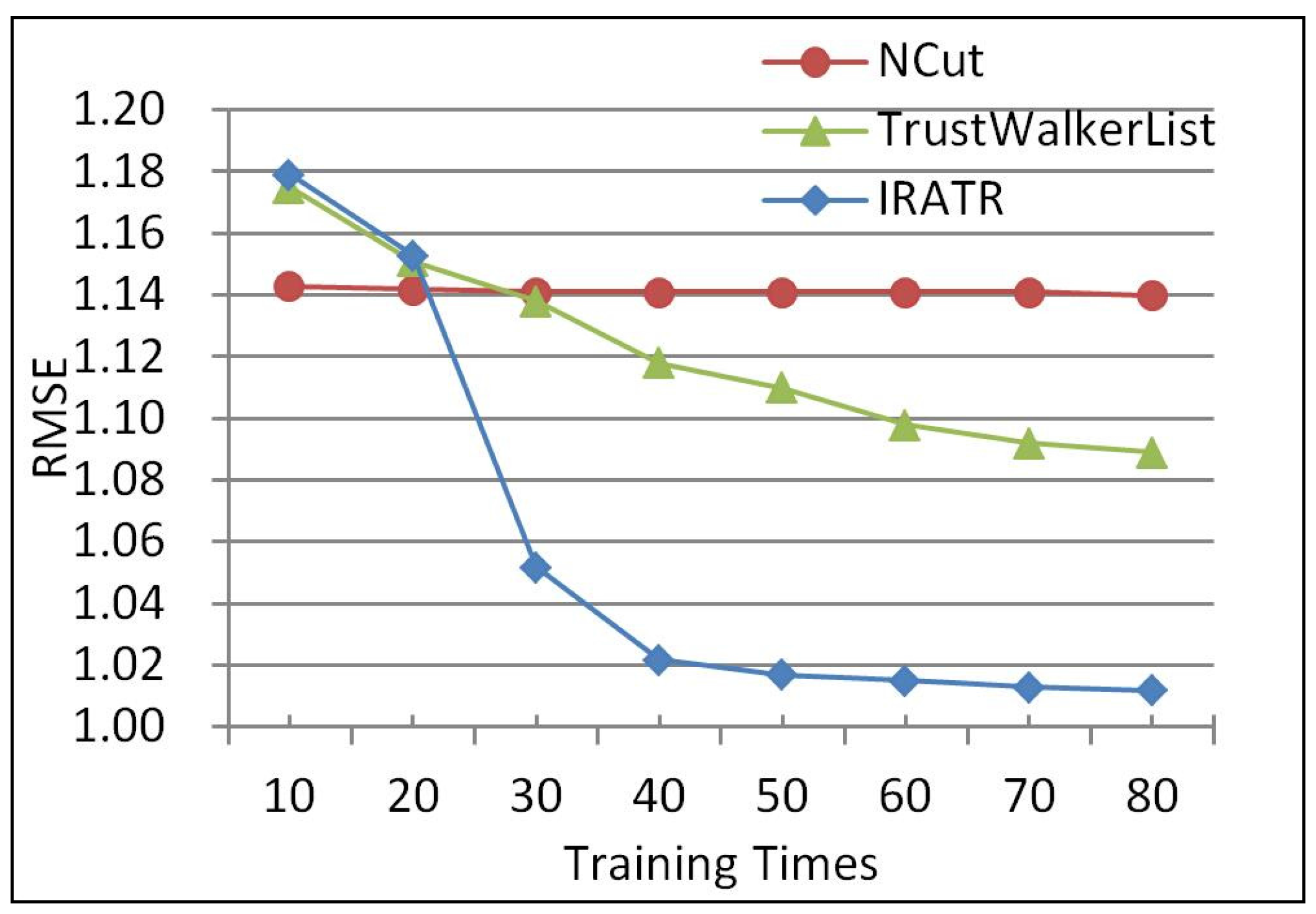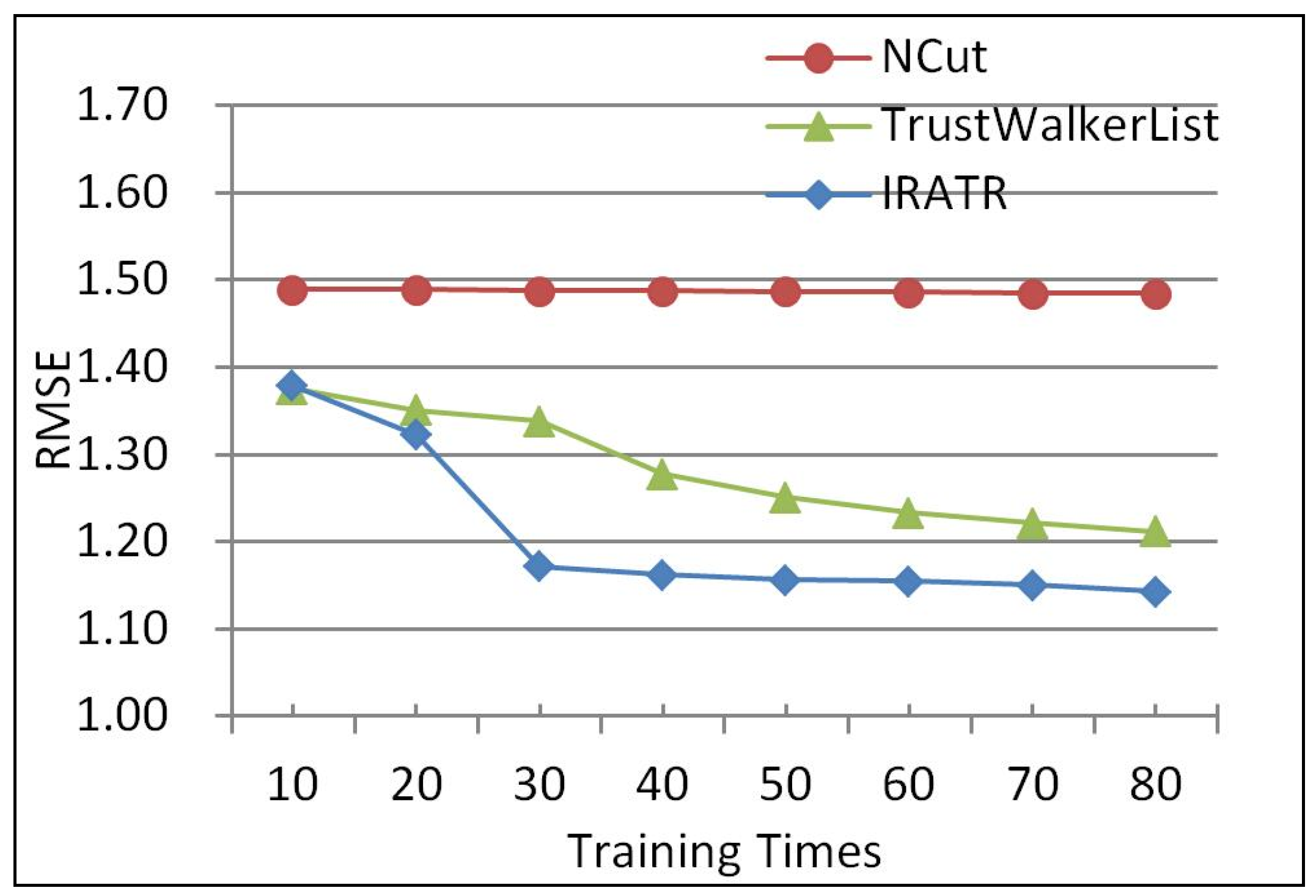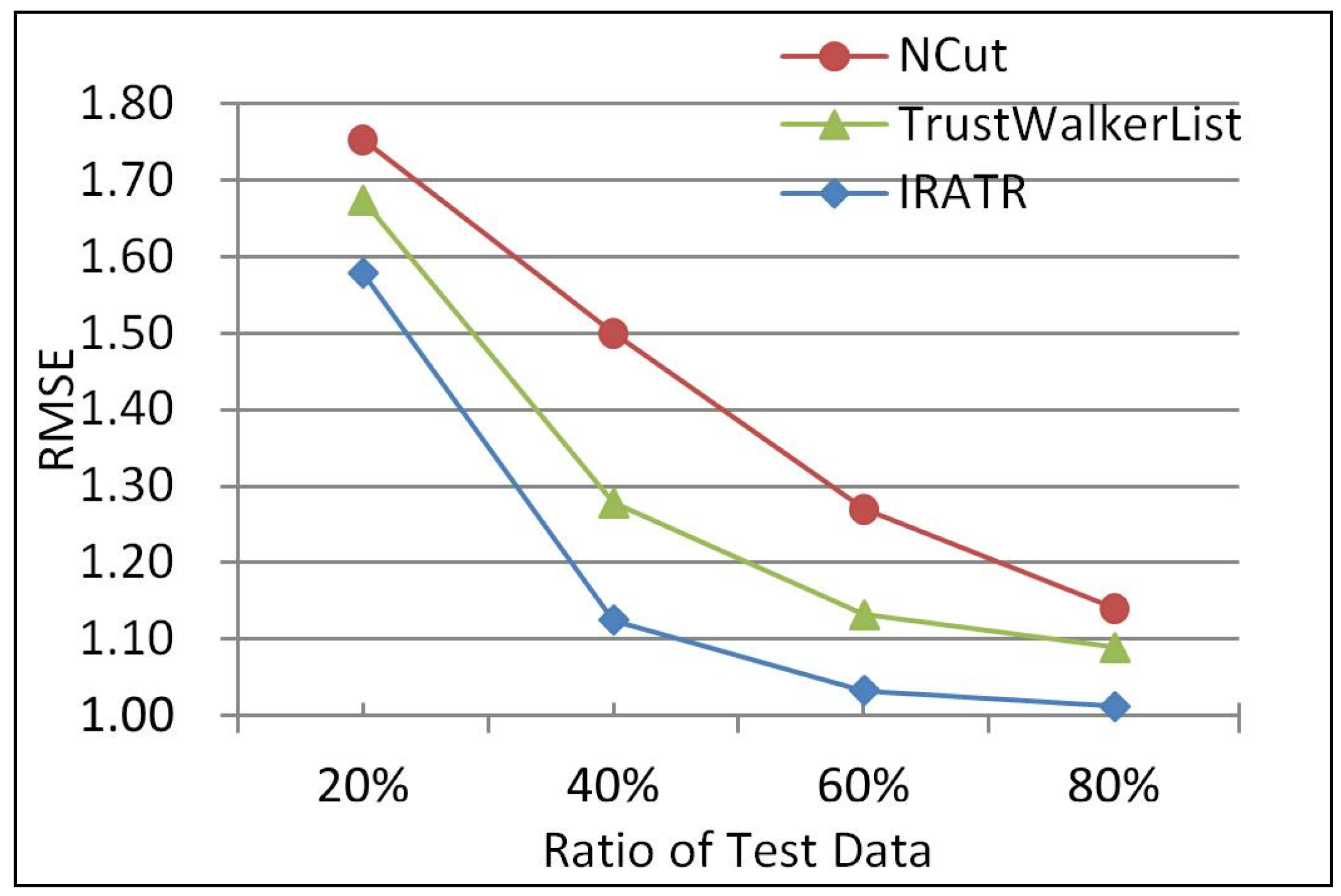Improved Recommendations Based on Trust Relationships in Social Networks
Abstract
:1. Introduction
2. Related Work
3. Factors in Trust Relationships
3.1. Definition of Trust
3.2. Dynamic Update of Trust
3.3. Similarity of Users
4. A Recommendation Algorithm Based on Trust Relationships
| Input: target user ua, the set of users U, the set of items I and the rating matrix R |
| Output: predicted ratings Ea for ua |
|
5. Experiment and Analysis
5.1. Experimental Setup
5.2. Results and Analysis
6. Conclusions
Acknowledgments
Author Contributions
Conflicts of Interest
References
- Walter, F.E.; Battiston, S.; Schweitzer, F. A model of a trust-based recommendation system on a social network. Auton. Agents Multi-Agent Syst. 2008, 16, 57–74. [Google Scholar] [CrossRef]
- Liao, Q.; Wang, B.; Ling, Y.; Zhao, J.; Qiu, X. Improved Recommendation System Using Friend Relationship in SNS. Trans. Comput. Collect. Intell. 2015, XIX, 17–31. [Google Scholar]
- Wang, G.; Gui, X. Selecting and trust computing for transaction nodes in online social networks. Jisuanji Xuebao (Chin. J. Comput.) 2013, 36, 368–383. [Google Scholar] [CrossRef]
- Deng, S.; Huang, L.; Xu, G. Social network-based service recommendation with trust enhancement. Expert Syst. Appl. 2014, 41, 8075–8084. [Google Scholar] [CrossRef]
- Can, A.; Bharat, B. Sort: A self-organizing trust model for peer-to-peer systems. IEEE Trans. Dependable Secur. Comput. 2013, 10, 14–27. [Google Scholar] [CrossRef]
- Park, C.; Kim, D.; Oh, J.; Yu, H. Improving top-K recommendation with truster and trustee relationship in user trust network. Inf. Sci. 2016, 374, 100–114. [Google Scholar] [CrossRef]
- Kim, S.; Yoon, Y. Recommendation system for sharing economy based on multidimensional trust model. Multimed. Tools Appl. 2016, 75, 15297–15310. [Google Scholar] [CrossRef]
- Ozsoy, M.G.; Polat, F. Trust based recommendation systems. In Proceedings of the 2013 IEEE/ACM International Conference on Advances in Social Networks Analysis and Mining, Niagara Falls, ON, Canada, 25–28 August 2013; pp. 1267–1274.
- Mohsen, J.; Ester, M. Trustwalker: A random walk model for combining trust-based and item-based recommendation. In Proceedings of the 15th ACM SIGKDD International Conference on Knowledge Discovery and Data Mining, Paris, France, June 2009; pp. 397–406.
- Jamali, M.; Ester, M. Using a trust network to improve top-N recommendation. In Proceedings of the Third ACM Conference on Recommender Systems, New York, NY, USA, 22–25 October 2009; pp. 181–188.
- Castillejo, E.; Almeida, A.; López-de-Ipina, D. Social network analysis applied to recommendation systems: Alleviating the cold-user problem. Lect. Notes Comput. Sci. 2012, 7656, 306–313. [Google Scholar]
- Lin, C.; Xie, R.Q.; Guan, X.J.; Li, L.; Li, T. Personalized news recommendation via implicit social experts. Inf. Sci. 2014, 254, 1–18. [Google Scholar] [CrossRef]
- Krauss, C.; Arbanowski, S. Social preference ontologies for enriching user and item data in recommendation systems. In Proceedings of the 14th IEEE International Conference on Data Mining, Shenzhen, China, 14–17 December 2014; pp. 365–372.
- Yilmazel, B.Y.; Kaleli, C. Robustness analysis of arbitrarily distributed data-based recommendation methods. Expert Syst. Appl. 2016, 44, 217–229. [Google Scholar] [CrossRef]
- Wang, G.; Gui, X. DRTEMBB: Dynamic Recommendation Trust Evaluation Model Based on Bidding. J. Multimed. 2012, 7, 279–288. [Google Scholar] [CrossRef]
- Shambour, Q.; Lu, J. A hybrid trust-enhanced collaborative filtering recommendation approach for personalized government-to-business e-services. Int. J. Intell. Syst. 2011, 26, 814–843. [Google Scholar] [CrossRef]
- Alejandro, B.; Parapar, J. Using graph partitioning techniques for neighbor selection in user-based collaborative filtering. In Proceedings of the Sixth ACM Conference on Recommender Systems, Dublin, Ireland, 9–13 September 2012; pp. 213–216.
- Wang, S.G.; Zheng, Z.B.; Wu, Z.P.; Lyu, M.R.; Yang, F.C. Reputation measurement and malicious feedback rating prevention in web service recommendation systems. IEEE Trans. Serv. Comput. 2015, 8, 755–767. [Google Scholar] [CrossRef]
- Tian, H. Research on User-Centered Web Service Discovery and Its Application in Financial Services; Wuhan University: Wuhan, China, 2014. [Google Scholar]
- Tian, H.; Fan, H.; Du, W. Research on Web service discovery based on user community relations. J. Commun. 2015, 36, 28–36. [Google Scholar]
- Massa, P.; Avesani, P. Trust-aware recommender systems. In Proceedings of the First ACM Conference on Recommender Systems, Minneapolis, MN, USA, 19–20 October 2007; pp. 17–24.




© 2017 by the authors. Licensee MDPI, Basel, Switzerland. This article is an open access article distributed under the terms and conditions of the Creative Commons Attribution (CC BY) license ( http://creativecommons.org/licenses/by/4.0/).
Share and Cite
Tian, H.; Liang, P. Improved Recommendations Based on Trust Relationships in Social Networks. Future Internet 2017, 9, 9. https://doi.org/10.3390/fi9010009
Tian H, Liang P. Improved Recommendations Based on Trust Relationships in Social Networks. Future Internet. 2017; 9(1):9. https://doi.org/10.3390/fi9010009
Chicago/Turabian StyleTian, Hao, and Peifeng Liang. 2017. "Improved Recommendations Based on Trust Relationships in Social Networks" Future Internet 9, no. 1: 9. https://doi.org/10.3390/fi9010009






